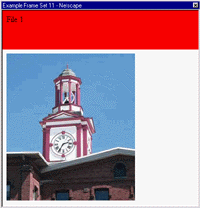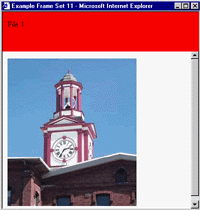|
Frames
Frame Margins
Simple Examples |
No Frames |
Borders and Borderless Frames |
Nested Framesets |
Frame Margins |
Naming Frames & Targeting Links |
Frames Exercise
To this point we've mostly loaded very simple HTML pages
into the frames of our various example frame sets: almost
every file had only a solid color background and a short
piece of text ("File 1", "File 2", etc.). Now let's look
at an example where one of the frames contains nothing but
a single image: Example
11.
| |
<frameset rows="20%,80%"
border="0">
<frame src="file1.html">
<frame src="clockt.jpg">
</frameset>
|
Example 11 opens the frame set in a new browser window
that is again 400 by 400 pixels. To illustrate our following
points, we've specified the window to not be resizable.
The top frame occupies 20% of the available height, and
so it is 80 pixels tall. The bottom frame occupies 80% of
the available height; it's 320 pixels tall. (We've used
borderless frames here, specifying border=0
above, to ensure that no space in the frame set gets eaten
up by the border between the frames. This was to guarantee
that we know for sure how tall the bottom frame is in this
case.)
The image loaded into the bottom frame is 263 pixels wide
by 300 pixels tall. So the image should fit into the bottom
frame, right? Well, maybe it does and maybe it doesn't.
That will depend on which browser you're using. In Netscape
the image does fit into the lower window, but in Internet
Explorer it doesn't: there is a vertical scroll bar in the
bottom frame. (The bottom of the image may be just slightly
above or slightly below the browser's edge - depending on
the version of IE.)
The images below are reduced to 50% of the actual size
displayed in the frame set.
 |
 |
|
Netscape
|
Internet Explorer
|
|
In both cases we notice something curious: the image doesn't
fit snugly against the top or left of the bottom frame.
There are instead margins between these edges of the image
and the bottom frame. (The image is just the rectangular
picture of the clocktower. The white background around the
picture is not part of the image; it's just the default
browser background.) If you look closely, you'll also see
that there are different top and left margins in Netscape
and IE. In fact, it's because IE has added more vertical
padding for the image than Netscape that we get the scroll
bar in the bottom frame when we view the frame set with
Explorer.
What's causing this extra padding? Why does the amount
of padding depend on the browser? Is there any way we can
control the amount of the padding, and maybe even get rid
of it altogether?
The amounts of padding are different in the two browsers
simply because the default margins for frames are
different for the browsers. But we can override the default
values by specifying the marginheight
and marginwidth attributes
of the frame tags. Here's what happens if we set marginheight
to zero: Example
11a. The HTML that creates the frame set is:
| |
<frameset rows="20%,80%"
border="0">
<frame src="file1.html">
<frame src="clockt.jpg" marginheight="0">
</frameset>
|
Note that although we only specified marginheight="0",
we got rid of the padding at the left as well as the padding
above the image. The same thing happens if we specify only
marginwidth="0": Example
11b; or if you set both margins to zero: Example
11c. (If you look very closely, you can see a
subtle difference in these three cases -11a, 11b, 11c -
with Netscape. What is it? You don't see this effect with
Explorer.)
We can also set either marginheight or marginwidth (or
both) to any other desired positive numerical value, if
this should be desired in a particular case. For example,
perhaps we wanted a large offset for some reason:Example
11d or Example
11e.
An Experiment: If you're using Explorer, you should
see a scroll bar in the bottom frame even if the image is
completely above the bottom edge of the browser window (i.e.,
above the bottom of the bottom frame). Why would that happen?
We can understand why if we view the frame set again with
the default margins, but this time open the set in a resizable
window: Example
11f.
As noted before, if you're using Explorer the lower frame
has a scroll bar, but if you're using Netscape it doesn't.
If your browser is Netscape, drag the lower edge of the
example's window upward about a half inch so that you can
perform the rest of this exercise. When you release the
mouse button you should now get a scroll bar in the bottom
frame. (You won't see the scroll bar while you're dragging
the window bottom vertically; you have to release the button
or drag the cursor horizontally along the bottom window
edge before the scroll bar will appear in Netscape.)
Regardless of your browser, you should now have a scroll
bar in the bottom frame of Example 11. Place your cursor
on the bottom edge of the example's window, hold down the
mouse button, and drag the bottom edge of the window downward
carefully. Drag just until the scroll bar disappears. (With
Netscape you'll need to drag a little and then release the
mouse button to see if the scroll bar has disappeared. If
it hasn't, drag a little more and release again, etc. until
the scroll bar does disappear. With Explorer you should
see the scroll bar resize and finally disappear as you drag.)
When does the scroll bar disappear? Is it when the bottom
edge of the lower frame (the window bottom) is just at the
bottom of the image? Or do you have to drag the bottom of
the frame lower than that?
In fact, the scroll bar does not disappear as soon
as the bottom of the frame is even with the bottom of the
image. You have to continue dragging the bottom frame downward.
If you look closely, you'll see that the scroll bar finally
disappears when the frame is at a distance below the image
that is equal to the marginheight padding that has been
inserted above the frame.
Now try dragging the right edge of the Example 11 window
to the left until you get a horizontal scroll bar along
the bottom edge of the frame. Then drag the right edge to
the right until that scroll bar just disappears. How does
the result of this experiment compare with the one you just
performed on the bottom edge of the frame?
As you've discovered, the value of marginheight and marginwidth
aren't just padding between an image and the top and left
edges of a frame. These quantities also specify the bottom
and right margins of a frame's contents. (You probably already
guessed that was the case?)
At the risk of belaboring the obvious, note that marginheight
and marginwidth specify a frame's margins regardless of
the frame's content. These margins don't just come into
play when a frame contains a single image like we used in
our previous examples. We illustrated these margin specifications
by using a frame holding a single image for a couple of
reasons. 1) The image was a fixed size and wouldn't "reformat"
when the browser window (and frame set) was resized; thus
we could avoid complicating the example with HTML text that
would reflow to fit a window as it changed size. Consequently,
we always knew the height of the frame contents, and could
determine whether it seemed reasonable or not that the contents
should fit in the frame without a scroll bar. 2) It's unlikely
that you'd ever choose zero sized margins for a frame that
contained text if such margins would cause the text to be
jammed right up to a frame's edge.
|